Z Score Probability Calculator
A Z Score Probability Calculator, also known as a Normal Probability Calculator, is a powerful tool that helps you quickly compute probabilities from the standard normal distribution. A z-score measures how many standard deviations a data point is from the mean, and it plays a key role in probability and statistical analysis. Instead of manually using lengthy z-tables, this calculator provides instant results with precise probabilities for left-tail, right-tail, between, or outside ranges. It also displays a shaded normal distribution curve to make results easy to understand visually. In this article, we explain what the calculator does, how to use it, key applications, formulas, and FAQs.
Probability from z score calculator
Please enter a z-score to instantly convert it into cumulative probabilities. This calculator works just like a z-table, but faster.
How to Use Our Normal Distribution Calculator
- Step 1 — Enter your z-score: Type a single z-value (e.g.,
-1.6). The calculator instantly computes all key cumulative probabilities. These include Probability, P(x<Z), P(x>Z), P(0 to Z or Z to 0), P(-Z<x<Z), and P(x<-Z or x>Z) - Step 2 — For two z-scores: If you want the probability between two points, simply enter both z-scores (e.g.,
-1.2and0.7). The calculator will return the probability between them along with a clear visual. - Step 3 — View instant results: All probabilities are displayed automatically with high precision. No manual selection of probability type is needed.
What is a Z Score?
A z-score tells you how many standard deviations a value lies from the mean in a normal distribution. A positive z-score means the value is above the mean, while a negative z-score means it is below. For example, a z-score of 1.5 indicates that the value is 1.5 standard deviations higher than the mean.
Z-scores are widely used in statistics to calculate probabilities, compare different datasets, and standardize test results. If you want to quickly compute or convert raw data into z-scores, you can try our easy-to-use Z Score Calculator.
Z Score Probability Formula and Explanation
The probability linked to a z-score comes from the standard normal distribution, which is a normal distribution with mean = 0 and standard deviation = 1. The cumulative probability of a z-score tells us the likelihood that a random variable Z will take a value less than or equal to that z-score.
Mathematically, this is written as:
$$P(Z \leq z) = \int_{-\infty}^{z} \frac{1}{\sqrt{2\pi}} e^{-\tfrac{t^2}{2}} \, dt$$
This formula looks complex, but here’s what it means:
- $$ \frac{1}{\sqrt{2\pi}} e^{-\tfrac{z^2}{2}} $$ is the probability density function of the standard normal distribution.
- The integral sums up all probabilities from −∞ (far left) up to your chosen z-value.
- The result is the cumulative probability, or the shaded area under the normal curve to the left of z.
Because the standard normal has mean 0 and standard deviation 1, every probability calculation depends only on the z-score itself.
Types of Z Score Probability Calculations You Can Do
The Z Score Probability Calculator makes it easy to compute all common types of probabilities under the standard normal distribution. Here are the four main cases, each with an example solved using the calculator.
1. Left-Tail Probability, P(Z<z)
This is the probability that a value lies to the left of a given z-score.
Example: A college admissions test is normally distributed with mean 500 and standard deviation 100. What proportion of students score below 595?
Solution
- Step 1 (Find z): $$ z = \frac{595 – 500}{100} = 0.95$$
- Step 2 (Use calculator): Enter z=0.95 and click the “calculate” button
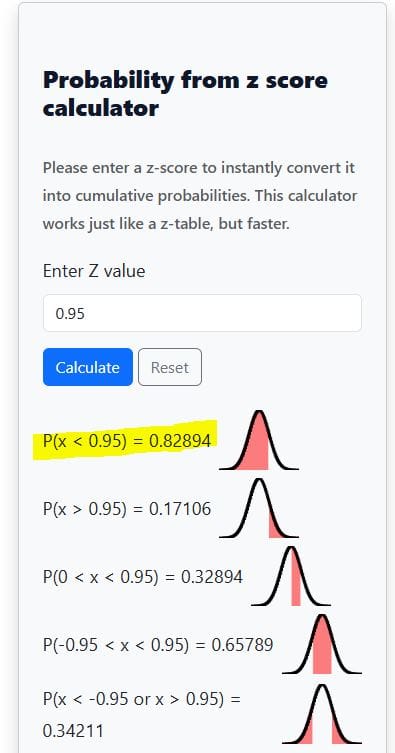
- Result: P(Z<0.95)≈0.8289
- Interpretation: About 82.9% of students score below 595.
2. Right-Tail Probability P(Z>z)
This gives the probability of a value being greater than a given z-score.
Example: A manufacturer knows that lightbulb lifespans are normally distributed with mean 1200 hours and standard deviation 150 hours. What proportion of bulbs last longer than 1110 hours?
Solution
- Step 1 (Find z) $$ z = \frac{1110 – 1200}{150} = -0.60$$
- Step 2 (Use calculator): Enter z=−0.60 and click the “Calculate” button
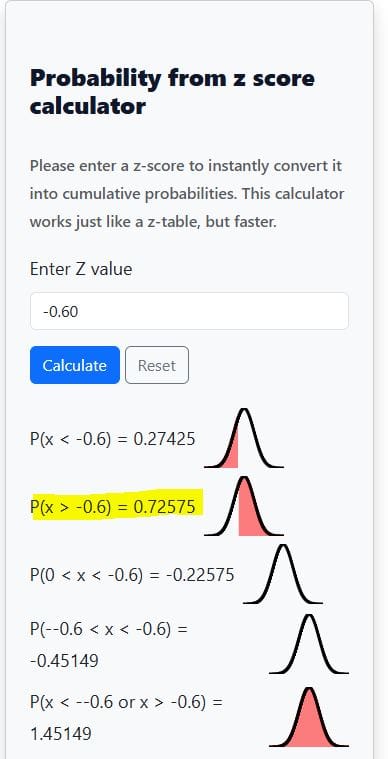
- Result: P(Z>−0.6)≈0.7257.
- Interpretation: About 72.6% of bulbs last longer than 1110 hours.
3. Between Two Z-Scores P(a<Z<b)
This gives the probability of a value falling between two z-scores.
Example: Heights of adult men are normally distributed with mean 70 inches and standard deviation 3 inches. What proportion of men are between 66 and 74 inches tall?
- Step 1 (Find z-scores): $$ z_1 = \frac{66 – 70}{3} = -1.33$$, $$\quad z_2 = \frac{74 – 70}{3} = 1.33$$
- Step 2 (Use calculator): Enter −1.33 and 1.33. Hit the “Calculate” button, as shown below
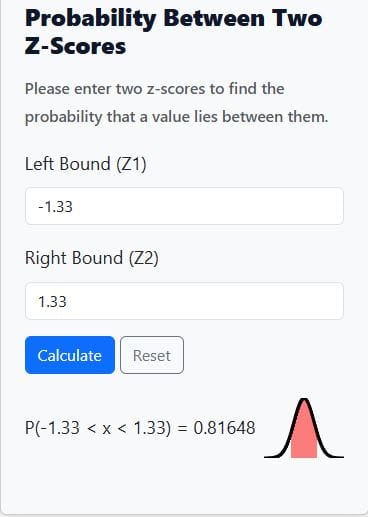
- Result: P(−1.33<Z<1.33)≈0.8165
- Interpretation: About 81.7% of men are between 66 and 74 inches tall.
Outside Two Z-Scores P(Z<a or Z>b)
This gives the probability of a value being less than the lower bound or greater than the upper bound.
Example: IQ scores are normally distributed with mean 100 and standard deviation 15. What proportion of people have an IQ below 77.5 or above 122.5?
Solution
- Step 1 (Find z-scores): $$z_1 = \frac{77.5 – 100}{15} = -1.5$$ , $$\quad z_2 = \frac{122.5 – 100}{15} = 1.5$$
- Step 2 (Use calculator): Enter the absolute value (In this case, 1.5)
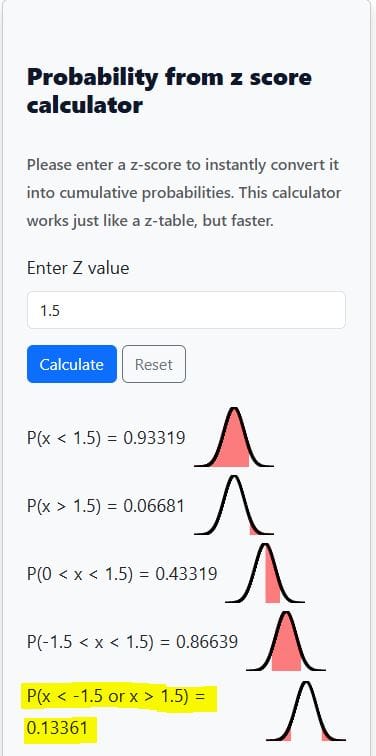
- Result: P(Z<−1.5 or Z>1.5)≈0.1336
- Interpretation: About 13.4% of people fall outside this range of IQs.
Using a Z Score Table to Find Probabilities
Before calculators and statistical software, the Z Score Table (or Standard Normal Table) was the main tool used to find probabilities under the normal distribution. A Z Table lists the cumulative probability (area under the curve) for every possible z-score value.
- A positive Z Table gives probabilities for z-scores greater than 0.
- A negative Z Table mirrors it for z-scores less than 0.
By looking up your z-score, you can find the probability that a standard normal variable is less than or equal to that value.
Here’s how to use the standard normal tables to find probabilities from z scores:
- Find the row for the first two digits of your z-score (e.g., 1.2 for a z = 1.25).
- Find the column for the second decimal place (e.g., 0.05 for a z = 1.25).
- Read the probability at the intersection — this gives you P(Z<z).
- For right-tail probabilities, subtract the value from 1.
- For between two z-scores, subtract the smaller cumulative probability from the larger one.
Negative Z Table (Negative Standard Normal Table)
The Negative Z Table is used to find probabilities for negative z-scores, which represent values below the mean in a standard normal distribution. Since the curve is symmetric around zero, these tables are essential when dealing with scores on the left side of the mean. By looking up a negative z-score, you can quickly determine the cumulative probability without manually calculating integrals. This is especially helpful in exam settings or statistics homework when normal probability calculators aren’t allowed.
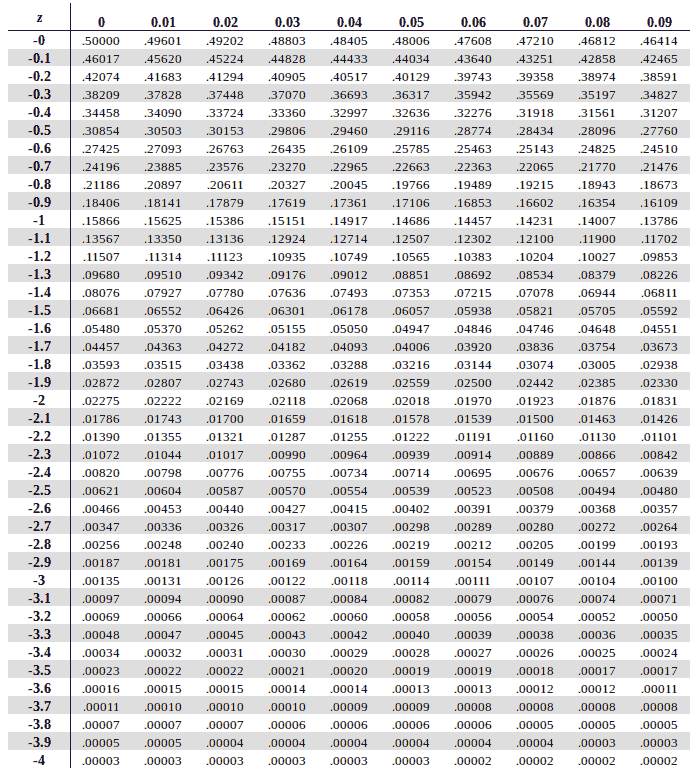
Example: Using the Negative Z Table
Suppose a student’s test score corresponds to a z-score of –1.25. We want to find the probability that a randomly selected score from the standard normal distribution is less than –1.25.
- Step 1: Identify the z-score. The z-score is –1.25, meaning the score is 1.25 standard deviations below the mean.
- Step 2: Locate the value in the negative z-table.
- Go to the row for –1.2.
- Move across to the column for 0.05 (since –1.25 = –1.2 – 0.05).
- Step 3: Read the probability. From the table, the probability is approximately 0.1056.
- Step 4: Interpretation: This means about 10.56% of the data lies below a z-score of –1.25.
Positive z table (Positive Standard Normal Table)
The Positive Z Table is used to find probabilities for positive z-scores, representing values above the mean in a standard normal distribution. By referencing this table, you can quickly determine the cumulative probability that a value falls below a given z-score without performing complex calculations. Positive Z Tables are widely used in exams, assignments, and statistical analysis to find probabilities for right-tail events, two-tailed tests, and confidence intervals. Combined with the negative Z Table, they provide a complete reference for all standard normal probabilities.
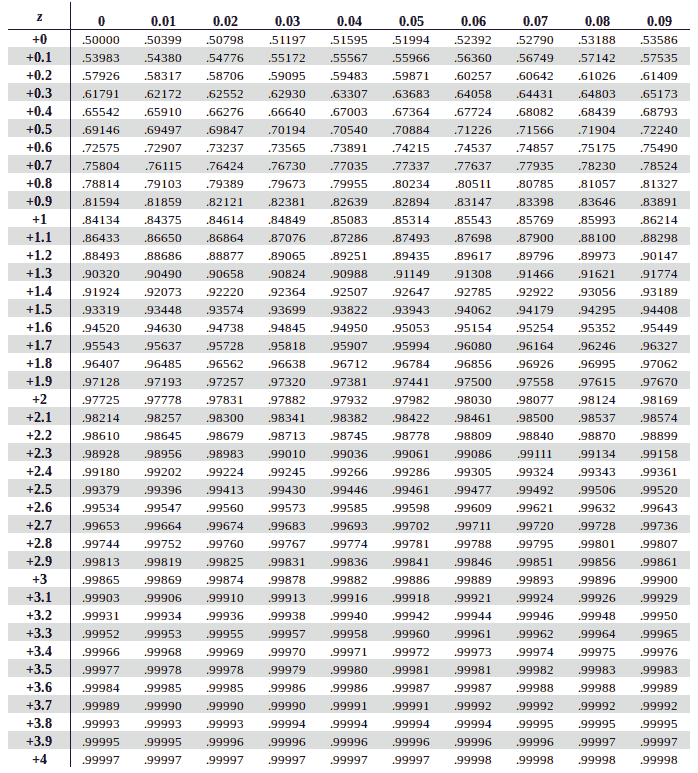
Example: Using the Positive Z Table
Suppose the time (in minutes) it takes employees to complete a task is normally distributed with mean = 50 minutes and standard deviation = 8 minutes. What is the probability that an employee completes the task in less than 58 minutes?
Step 1: Convert the raw score to a z-score $$ z = \frac{X – \mu}{\sigma} = \frac{58 – 50}{8} = 1.0$$
So, z=1.0
Step 2: Locate the z-score in the positive Z Table
- Look at the row for 1.0 and column 0.00 (since 1.0 has no extra decimal beyond the first digit).
- The table gives a cumulative probability of 0.8413.
Step 3: Interpret the probability
P(X<58)=P(Z<1.0)≈0.8413
This means there is approximately 84.13% chance that a randomly selected employee finishes the task in less than 58 minutes.
Frequently Asked Questions
A Z Score Probability Calculator, also called a Normal Distribution Calculator, is an online tool that computes probabilities for any z-score under the standard normal distribution. It shows left-tail, right-tail, between, and outside probabilities with a shaded curve for easy visualization.
Simply enter one z-score to get all cumulative probabilities (left-tail, right-tail, and outside). If you want the probability between two values, enter both z-scores, and the calculator will display the exact probability along with a shaded normal distribution graph.
Yes, the calculator works as the digital version of a z-table. Instead of manually looking up values, the Z Score Probability Calculator gives precise probabilities instantly and allows for decimal z-scores that are often missing in printed tables.
Absolutely. Many students and researchers use the calculator to find critical values, p-values, and tail probabilities needed in z-tests, confidence intervals, and other hypothesis testing scenarios.
The left-tail probability (P(Z<z)) gives the area under the curve to the left of your z-score, while the right-tail probability (P(Z>z)) gives the area to the right. The calculator automatically provides both so you don’t have to subtract manually.
Yes. If you enter two z-scores, the Normal Distribution Calculator returns the probability of a value falling between them and highlights the shaded area on the normal curve. It can also calculate the probability of being outside those two values.
